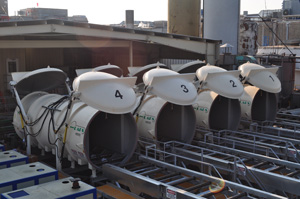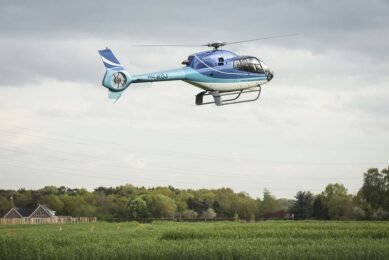Slow controlled decompression for humane stunning

Low atmospheric pressure system (LAPS) stunning has the potential to improve welfare of poultry at slaughter by eliminating the stress associated with live bird shackling. LAPS is an irreversible method which has been tested for some years and is currently in operation under commercial conditions. The results seem promising.
By Dorothy EF McKeegan and Dale A. Sandercock, Institute of Biodiversity, University of Glasgow, UK, Marien Gerritzen, Wageningen UR Livestock Research, Lelystad, The Netherlands, Yvonne V Thaxton, Center for Food Animal Wellbeing, University of Arkansas, Fayetteville, AR USA and Karen D. Christensen, OK Foods, Fort Smith, AR USA
A search for an optimum method for humanely slaughtering poultry has been the subject of research for years. To be considered humane, the slaughter method requires that there be minimal signs of agitation and distress while the birds have any degree of perception or consciousness. Therefore, a humane approach to stunning must produce insensibility as rapidly and painlessly as possible. The primary methods for poultry currently used are electrical stunning and controlled atmosphere stunning (CAS), using various gas mixtures.
Research into the welfare implications of both of these methods suggests that they have different welfare costs and benefits. For gas systems, concerns focus on unpleasant sensations for the birds before loss of consciousness, while electrical stunning involves painful shackling and inadequate current delivery gives rise to the possibility of ineffective stunning. In addition, the capital cost for gas systems is high and they have an on-going expense of operation which together have been a deterrent to its wide spread adoption.
Reduction in air pressure
To address these concerns, US company TechnoCatch, known primarily for its automated poultry harvester, sought another technology. Over the last six years, the company has been working with a number of scientists to perform research leading to a new method which utilises hypoxia (lack of oxygen) through reduction in air pressure rather than by immersion in a controlled gas environment.
To address these concerns, US company TechnoCatch, known primarily for its automated poultry harvester, sought another technology. Over the last six years, the company has been working with a number of scientists to perform research leading to a new method which utilises hypoxia (lack of oxygen) through reduction in air pressure rather than by immersion in a controlled gas environment.
This new system, low atmospheric pressure system (LAPS) stunning, mimics ascent to high altitudes and utilises the associated reduced oxygen tension, which renders birds unconscious and eventually induces a non-recovery state. Low atmospheric pressure is achieved using slow, controlled decompression which allows the body to adjust to changes in pressure with minimal or no discomfort.
Eliminating stress
Misunderstanding the precise and slow LAPS method has led some to confuse it with rapid decompression. Objections to rapid decompression are legitimate, because according to the American Veterinary Medical Association, “Many chambers are designed to produce decompression at a rate 15 to 60 times faster than that recommended as optimum for animals, resulting in pain and distress attributable to expanding gases trapped in body cavities.”
Misunderstanding the precise and slow LAPS method has led some to confuse it with rapid decompression. Objections to rapid decompression are legitimate, because according to the American Veterinary Medical Association, “Many chambers are designed to produce decompression at a rate 15 to 60 times faster than that recommended as optimum for animals, resulting in pain and distress attributable to expanding gases trapped in body cavities.”
However, other research has established that when decompression is achieved slowly with proper controls, it can be humane. Thus, a precisely controlled LAPS system could be useful for commercial slaughter of poultry, having the potential to improve welfare by eliminating the stress associated with live bird shackling and ensuring effective stunning of every bird.
No damage of tissue
The LAPS unit was designed after six years of extensive research, at both Mississippi State University and a commercial processing plant. Throughout development, smaller research scale units as well as larger commercially applicable units have been constructed to establish the desired parameters which meet all of the requirements for humane slaughter. In an important early study, tissues of every major organ were taken from broilers subjected to LAPS and submitted to a board certified veterinary pathologist along with the same tissues from electrically stunned birds. The pathologist was blinded to the method of stunning and the results showed that there was no damage to any tissue as a result of either method of rendering the birds insensible. In particular, ear drums were examined for damage (as a vulnerable site for compression injury) with none found. Thus it was established that LAPS did not cause pain through damage to the birds, and this was also a finding with important implications for further processing.
The LAPS unit was designed after six years of extensive research, at both Mississippi State University and a commercial processing plant. Throughout development, smaller research scale units as well as larger commercially applicable units have been constructed to establish the desired parameters which meet all of the requirements for humane slaughter. In an important early study, tissues of every major organ were taken from broilers subjected to LAPS and submitted to a board certified veterinary pathologist along with the same tissues from electrically stunned birds. The pathologist was blinded to the method of stunning and the results showed that there was no damage to any tissue as a result of either method of rendering the birds insensible. In particular, ear drums were examined for damage (as a vulnerable site for compression injury) with none found. Thus it was established that LAPS did not cause pain through damage to the birds, and this was also a finding with important implications for further processing.
At this stage of development, it was necessary to move to large scale commercial testing which, for use in the United States, required a testing protocol acceptable to the United States Department of Agriculture’s office of New Technology. Further research was undertaken to determine optimal operating parameters to provide a humane method of stunning broilers without creating processing problems. The results were positive and clearly demonstrated the efficacy of the method and showed that issues such as bleeding and determinations of birds dead from other causes were not problematic. The method was given a ‘no-objection’ ruling and has been in use in a commercial plant in Arkansas since the beginning of 2011.
Assessment of welfare
With various methods of stunning of poultry (including LAPS), induction of unconsciousness is not immediate, and from the point of view of bird welfare, the most important issues are the time taken for the birds to lose consciousness, and what negative sensations they might experience while conscious. Measurement of appropriate physiological responses allows an assessment of the potential welfare insults experienced by the birds during the conscious phase.
With various methods of stunning of poultry (including LAPS), induction of unconsciousness is not immediate, and from the point of view of bird welfare, the most important issues are the time taken for the birds to lose consciousness, and what negative sensations they might experience while conscious. Measurement of appropriate physiological responses allows an assessment of the potential welfare insults experienced by the birds during the conscious phase.
Of particular relevance is the electroencephalogram (EEG), an electrically measurable signal that reflects the overall activity of the brain and exhibits clear changes in its characteristics during different awareness states (e.g. awake, drowsy, sleeping, unconscious, see Figure 1). Thus EEG monitoring allows a determination of global brain activity, which can be analysed using various techniques to evaluate likely time of loss of consciousness and onset of non-recovery states. This approach is well established and is a crucial measure since welfare assessment must focus on events occurring before loss of consciousness. Measurement of the electrocardiogram (EKG) is also useful as increases in heart rate are associated with various welfare insults such as fear and pain.
Rapid loss of consciousness
To systematically investigate the welfare implications of LAPS, TechnoCatch arranged for researchers in Europe with experience in performing EEG and EKG monitoring on other stunning methods to perform some preliminary tests on market age broilers undergoing LAPS in a single bird chamber. Although only a small number of birds were tested, the results from this study were encouraging, suggesting that LAPS induced rapid loss of consciousness and no strong aversion-pain related or aversive behavioural responses were observed in the conscious phase. It was also noted that the heart rate of the birds did not significantly increase during induction of unconsciousness, which would be expected if birds were experiencing negative welfare states.
To systematically investigate the welfare implications of LAPS, TechnoCatch arranged for researchers in Europe with experience in performing EEG and EKG monitoring on other stunning methods to perform some preliminary tests on market age broilers undergoing LAPS in a single bird chamber. Although only a small number of birds were tested, the results from this study were encouraging, suggesting that LAPS induced rapid loss of consciousness and no strong aversion-pain related or aversive behavioural responses were observed in the conscious phase. It was also noted that the heart rate of the birds did not significantly increase during induction of unconsciousness, which would be expected if birds were experiencing negative welfare states.
Not distressing
After conducting these preliminary studies, the next step was to perform the same type of experiment in a commercial LAPS unit, measuring the EEG and EKG of a larger number birds to provide more robust and commercially relevant information about the system. A trial was undertaken in which the EEG and EKG responses of 28 market age broilers were measured. These birds were instrumented with a data logger designed to record the physiological signals and were added to modules of commercially reared birds during 28 individual cycles of the commercial LAPS system.
After conducting these preliminary studies, the next step was to perform the same type of experiment in a commercial LAPS unit, measuring the EEG and EKG of a larger number birds to provide more robust and commercially relevant information about the system. A trial was undertaken in which the EEG and EKG responses of 28 market age broilers were measured. These birds were instrumented with a data logger designed to record the physiological signals and were added to modules of commercially reared birds during 28 individual cycles of the commercial LAPS system.
Analysis of the EEG recordings showed that loss of consciousness was gradually induced by LAPS and was achieved before behavioural responses associated with loss of posture and convulsive wing flapping took place. As with the earlier pilot trial, there was a lack of behavioural responses indicating aversion, fear or escape during LAPS induction and the absence of heart rate elevation in the conscious period strongly suggested that birds do not find LAPS induction distressing.
Collectively, the results of this extensive program of research into the welfare implications of LAPS have shown that compared to other stunning approaches, LAPS has the potential to improve the welfare of poultry at slaughter by producing a gradual and uniform induction of unconsciousness (non-recoverable) in birds, thereby avoiding the use of potentially aversive gas mixtures, and ensuring every bird is adequately stunned. In addition, this approach does not subject the birds to painful pre-slaughter shackling or pre-stunning electric shocks associated with other slaughter methods.
MORE INFORMATION
Join 31,000+ subscribers
Subscribe to our newsletter to stay updated about all the need-to-know content in the poultry sector, three times a week. Beheer
Beheer








 WP Admin
WP Admin  Bewerk bericht
Bewerk bericht